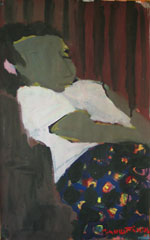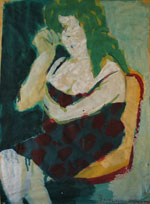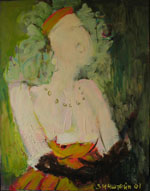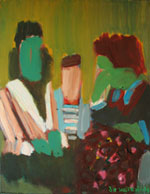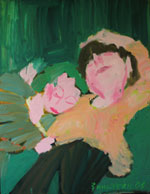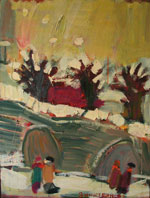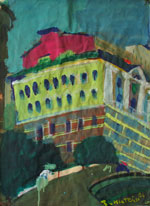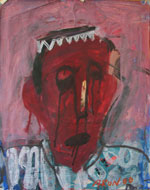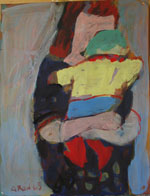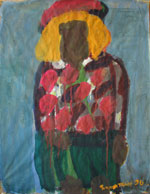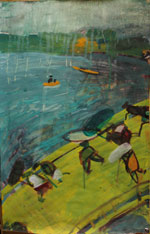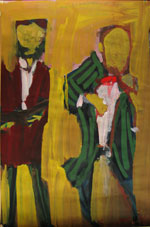 |
 |
| Articles about Aron Zinshtein's Painting |
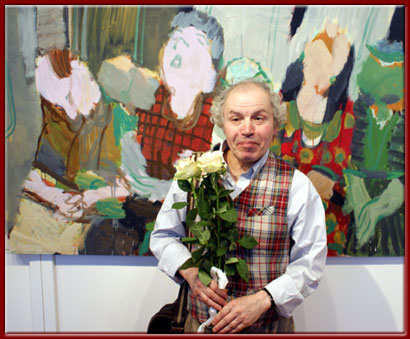 |
|
|
Aron Zinshtein's Painting, or "Why the Cow Casts No Shadow"......clatter of streetcars and swirl of people...... In his talks about art, Aron Zinshtein always recalls children's drawings. At first sight, this does not seem strange, for one would hardly find an artist who dislikes it. However, the case of Zinshtein is different. Zinshtein's referrences to the children's drawings reveal the nature of his own gift and formulate his general credo. Aron Zinshtein - mature master and wise man - has remained a child. Very few people manage to preserve the childhood perception of life after they acquire experience and gain sophisticated professional skills. Very few people remain capable of being amazed and excited and even fewer of them are able of making daily discoveries and believing in their fantasies. In fact, Zinshtein's works connote stylistically with children's art. However, this has nothing to do either with banal imitations or reflexive "appropriation", however fashionable the latter may be nowadays. His works are childish due to the coincidence of vision. In Zinshtein's case, the master and the child form "the union of perception"[1]. Freedom of improvisation and selfless attitude to art, being the basic features of children's art, also appear the key categories of Zinshtein's figurative world. In terms of typology, Zinshtein's art belongs, beyond a doubt, to the broad expressionist trend determinative for the 20th century's art (it was childhood drawing that this trend took as one of its sources). As a notion, expressionism is not merely a label of a given art movement. Rather, it defines the type of artist's consciousness and plastic temperament. Features of the expressionist temperament are evident in Zinshtein's works. He privileges expression over figurative image; he actively deforms reality; he is inclined to make his plastic interpretation of the nature emphatically characteristic; he has uncontainable imagination; his painting is "loud", elemental, vivacious, and spontaneous; his brushstroke is dashing and vibratory; his colour is always reinforced and emotionally charged; his intonation is utterly sincere and open. In fact, German expressionism in general and Ernst Ludwig Kirchner, Karl Schmidt-Rottluff and Emil Nolde in particular are among Zinshtein's most significant predilections in art. However, despite their perfect expressionist lexicon, Zinshtein's works show a totally different tonality of perception that can be easily ascribed to impressionism. Like a child, he toys with paints and derives visible pleasure from the very process of painting. His philosophy is that of joy. He never sentimentalises pain, hope and despair. There are a lot of pranks and tricks in his works. Zinshtein's art was developing at the time when Europe experienced a new wave of interest for painting in its spontaneous and expressive forms. The young artist was hardly aware of the Neue Wilde movement and the trans-avant-garde. Anyway, the emphasised radicalism of these movements could have hardly been sympathetic to him. However, the coincidence of the general vectors of development is quite important. What was more significant for Aron Zinshtein's development is the original tradition of Leningrad expressionism of 1930 - 1940s that was primarily formed by the Circle of Artists group (A. Rusakov, V. Pakulin, G. Traugot). Several decades later, the influence of the group was still significant in the city. Zinshtein's lineage also includes O. Gilderbrandt-Arbenina and V. Ermolaeva. However, some of Zinshtein's works are close to the manner of these artists due to the "memory of style" rather than because of direct influence or his consistent interest. Among contemporary artists, Anatoly Zaslavsky is closest to Zinshtein, both in life and art. They belong to the same artistic milieu and share views on art. Both of them are artists par excellence - they cherish plastic freedom, uninhibited hand and liberated feeling. Both draw inspiration from the earthbound situations and everyday life. This similarity notwithstanding, they remain independent and different in their art. Zinshtein's oeuvre consists of a vast number of works - files of etchings and linocuts, hundreds of canvases and no less than a thousand gouaches of various sizes. Such efficiency can partly be explained by Zinshtein's excitable temperament, vivacity of his perception and rapidity of his painting. In fact, Aron works very quickly trying to accomplish his plan outright, with no later corrections. It is more important for him to render the feeling and preserve integrity of the current emotional state. In this sense, Zinshtein's enormous productivity is determined by the very essence of his figurative conception. What he wants to depict is "the mass of life". His pictures are the stopframes of the ceaselessly moving film of human life. Theoretically, there should be the infinite number of them to catch each and every moment of being. Zinshtein's art seems to be so inadvertent in its presentation of the up-to-the-minute situations that it may well be characterised as the instantaneous painting. His subjects are usually deprived of any significant events. He paints people in action and the dynamics of the situation of action (that of watching, listening, speaking, singing, playing music, sitting, standing, and walking)[2] is rendered by means of his "express-painting". Zinshtein's manner reminds one of Daniil Kharm's ironical miniature in which he philosophises on the meaninglessness of the expression carpe diem: "I tried to seize the hour but failed and broke my watch. Now I know that this is impossible... It is quite another matter if one says "catch what is going on at the moment"... This is quite another matter. For example, I am saying: one, two, three. Nothing has happen! I have caught the moment in which nothing was going on. I told this to Zabolotsky. He liked the trick very much and spent the whole day counting: one, two, three! Every time he registered that nothing has happened. Shvarts found him busy with counting. He, too, got interested in this original way of catching what is going on in our epoch - because moments run into epochs"[3]. Kharms is the author of the whole series entitled Accidents, a collection of "episodes", "anecdotes", "illustrations", "stories", and "happenings". Kharm's term seems to provide the all-embracing definition of Zinshtein's painting, with its odd contents and the general composition of discrete but coherent narration. Each of his paintings is an individual and often autobiographical "accident" similar to those described by Kharms. Here is a random example: "One day a person went to his office and met another person who was going homeward after he bought a Polish loaf. That's all, properly speaking."[4] Zinshtein explains his subjects in a similar way: "we were waiting at the bus stop", "one day we listened to Olga playing on an organ and than ate a cake", "here we had our photograph taken during Zaslavsky's exhibition at Lesnoye". Integrity of the whole is based on the concatenation of such cases. I am far from making direct comparisons between Kharms and Zinshtein. They have different philosophies and possess different styles. Zinshtein does not have either Kharms' obduracy or his "sinister anti-logic" and irrationality. However, some Oberiuts' intonations are present in Zinshtein's paintings. They are evident in his interest to the type of a city inhabitant as well as in the joyful absurdism of the situations he paints. General eccentricity of his plastics and the actable distinctness of his images are also similar to Oberiuts' aesthetics. Zinshtein reinforces his subjects-accidents by means of his plastics. He is fond of "accidental" compositions. Figures of his personages are partly "off-camera"; the picture is positioned toward a side, with people turning their backs upon the spectator. Colours have hardly time enough to take the necessary shape and often do not coincide with the "jumping" contours. Zinshtein's hasty brush quickens the tempo of the strokes and often leaves the paints dripping freely. His last gouaches contain "accidents" in the very shape of sheets - distorted, notched and deckle-edged. The line from Bulat Okudzhava's old song I chose as the epigraph shows the dominants of Aron Zinshtein's world with great delicacy. In fact, his landscapes are focused on the rhythms and sounds of city life arbitrarily amplified by his imagination ("the clatter of streetcars"). Cityscapes appear transformed beyond recognition. St. Isaac's rigid firmament is turned into a graceful light colonnade. It is melting and trembling in the pink haze. The colourful spray it is showering all around transmutes into cars and pedestrians. Alexander Column, deprived from its cold solemnity, is dancing together with tourists. The thunderous Bronze Horseman is vanishing in the crowd. Zinshtein is fond of city hustle and huddle. He has a clear predilection for painting the "swirl of people". Situations that attract his attention vary from the overcrowded subway, track-racings and soccer matches to the theatre performances, music concerts and art exhibitions. He paints city promenades, market places, people dining in the restaurants, orchestras and choruses. Each situation has its own meaning in the composition of the picture: the rave of sportsmen differs from the inspiration of musicians and the tensity of subway passengers. However, on all pictures individual faces and figures grow indistinct and form the floating "human substance". This motive of the human hive is deprived from any critical and satirical pathos. What attracts the artist is its plastic expression and phantasmagoric staginess. Unlike most of contemporary artists, Zinshtein takes the crowd organically rather than psychologically and sociologically. Zinshtein's works can be divided into two large groups. The first depicts the actions of strangers; it pictures people taken out of crowd by the artist's visile and inquisitive glance; it presents those who accidentally deserved his artistic attention. The second group is devoted to Zinshtein's family circle; it portraits his children, family members and friends. Such reference to the real people allows a strange spectator to better realise the acute difference between the image and the reality. Family members derive additional pleasure from the process of recognition. They get a chance to appreciate Aron's work of imagination as well as precision and expression involved in the transformation of his nature. Among his personages, Zinshtein privileges women over men. What attracts him in women is diversity of garments, staginess of conduct and the wealth of outward reactions. Children, too, often appear among his personages. For Zinshtein, the "childhood perception" is inspiring both as a specific language and as a rich topic. A large number of works is devoted to music. His characters are singing, playing on various instruments (like most of artists, Zinshtein is particularly fond of violin and guitar), and listening to music. Such melomania cannot be ascribed solely to the artist's good taste for music and his personal experience of frequenting concerts and musicales. What seems to be more important for Zinshtein is the visual expressionism of actions and figures that is so characteristic of musicians. It is particularly noticeable in the "mute" situation when the showy costumes, exaggerated gestures, dynamic postures, bright characters and powerful passions come out to the foreground. Public forms a no less interesting picture of the visualized perception of music. These subjects seem to actualise Zinshtein's deepest allegiance to music, both intellectual and linguistic. Notably enough, music terminology appears to be pertinent to the description of his works. Accords, dissonance, counterpoint, major, tempo, forte, presto are well applicable for this task. Zinshtein usually pays little attention to the faces of his personages. As I have already mentioned, they often turn their backs upon the spectator so that the picture appears to be focused on their napes, hair and hats. When the artist happens to paint the front view, the visages get out adumbrant and "abridged", if not completely absent. Such device is common for the 20th century's Russian art. It suffices to mention Kazimir Malevich's semi-idola, Nikolay Suetin's suprematist faces, Vera Ermolaeva's sportsmen, boys and peasant women, and Alexander Arefyev's hooligans. Zinshtein's method is most similar to that of Vera Ermolaeva who "omits" the faces of her peasant women for the sake of better plastic expression that is spontaneously required by painting itself. Other artists mentioned paint "the absence of face", each pursuing the purpose of symbolic generalisation. By means of the omitted face, Zinshtein emphasises other individual features, namely the constitution of bodies, postures, manners, garments and hairstyles. Thus, the role of attributes, accessories and various details of dress appears to be exaggerated while their size is usually enlarged. Here and there, Zinshtein accentuates a splendid hattock, an unthinkable collar, a redundant bow, a plateresque purse, and large earrings. Despite the absence of faces, people are easily recognisable. In case their figures are deprived of the telling details, the very process of identification suggests the intrigue that no likeness of a portrait would ever provide. Like on a child's drawing, the face is often substituted with a characteristic feature or an important trait: an opened mouth, fiery plumpy lips, a big nose, a winking eye, and moustache may stand for the whole figure. Expression of a situation is frequently rendered by the accentuated object. The violin has changed its natural brown colour into the flamboyant red and thus formed the sense-centre of the picture. It has become very small, soft and pliant - like a child, it has trustfully nestled up to the musician's shoulder. Importantly, all these effects are produced by painting alone. Zinshtein cherishes the unpredictable strokes of his uninhibited brush. He is magnetised by the conversions: brushstrokes turn into a figure, spots transmogrify into faces, colours form a shape, planes constitute the space, and the lifeless transfigures into the animated. Painting turns out to be the life itself. Life converts into painting. Aron Zinshtein has a great liking for the definition "beautiful". It frequently appears in the titles of the works - e.g. Following a Beautiful Girl in the Subway (2000). However, Zinshtein's "beauty" falls short of usual - fashionable or classic - standards. The "beautiful" is that what is taken to extremes of distinctness, expressiveness, gaudiness, banality, and incorrectness. Here again I can't help quoting OBERIU: Zinshtein's account of beauty as well as his usual means of its description apparently coincides with that of Nikolai Oleynikov [5]. "Beauty" is the synonym for exaggeration and grotesque. Zinshtein's characters are often funny and awkward whereas the artist's view is not short of irony. Nonetheless, it is not essential in the author's attitude toward them. Zinshtein manifestly admires his personages; all his painterly judgments end with the bold exclamation mark. Up to this point I was describing Zinshtein's art as some stable integrity. It is both possible and necessary to consider it as the process of change and development. Gouaches and paintings of the early 80s are the works of an experienced graphic artist who is used to illustrating metaphorical literary texts. There are many sophisticated devices, manifest theatricality, and staged "fairy" stories. The characters' appearance reminds one of masks, marionettes, and puppets. One can perceive some emotional and plastic overstrain. In mid-80s, the artist's search for free painting brings about multiple composition and abatement of subject matter. In his landscapes, space is usually seen from above, it is rampant and seems to "turn over", thus rendering centrifugal character to the composition. Besides, the artist often lightens the flatness of the picture by rendering it - with colour score, composition shifts, and facture - properties of a flimsy fabric. By this time arises the mentioned artist's interest for depicting collective actions. In 1987 I wrote an article on Aron Zinshtein's art. I argued that the potential of his further artistic development was hidden in his large picture Festive Board. The guess turned out to be correct. Now it is obvious that this was not only a successful work but also a principal one. All features of the ensuing painting of Zinshtein - the range of constant subjects, personages with blurred visages, compositional devices, and plastic principles - owe much to that picture. Whirling brushstrokes, throng of blots, and flimsy colourful haze are replaced with distinct, extensional and dense views. In their move within the canvas, these views gravitate to each other and "stick" to the proper place. In 90s, this artistic language becomes more complicated. The artist enlarges the size of the figures and composes the picture with heavy factured colour masses thus keeping spectator's glance from sweeping through the picture. Spectator must work to feel the power of coherence, perceive the energy of colour radiation, and fix the layering of the flatness. The process of form construction is naked in the pictures of that period. The latest pictures are distinguished by the remarkable integrity of artistic Weltanschauung that is combined with the plainness of performance. This is an amazing outcome for the artist who started as a graphic working in the toilful dry-point technique. In the leaflets and catalogues, Aron Zinshtein's biography looks quite safe: graduated from a college in Nizhny Tagil, then Mukhina Art Academy, membership in the Union of Artists, the formidable list of solo and international exhibitions. In fact, the life of the artist was not that smooth. I have known Aron Zinshtein for 20 years. The circumstances of our acquaintance are quite illustrative of the time when notions "official" and "unofficial" did not cover the whole spectrum of things. In fall 1982 Zinshtein as a member of the Youth Group at the Leningrad Department of the Union of Artist was offered an exhibition. He was happy with this, as there were not so many possibilities to show one's works at that time. He chose his best works - white gouaches (on black paper), whirled dramatic landscapes, and odd everyday scenes with grotesque figures. However, the vernissage turned into a tonguelashing. The eminent functioners who had no idea of the artist's activities were shocked at what they saw. Zinshtein was stigmatised for formalistic distortion of true life and the "chagallism" unacceptable for a Soviet artist. This response seemed to be insufficient and it was decided to organise a discussion involving young critics. I was among the latter. No need to say that I supported the artist, his creative world and right for his own expression. I still have the entry in my dairy dedicated to that event and the outline of my "speech": coherent emotional and formally integral perception, acute painterly sense, plastic temperament, ability to surprise and transfigure, combination of the funny and the odd, lyrics and drama, expressionistic nature of art. This is how we got to know each other. A visit to the artist's studio intensified my sympathy that later developed into a friendship and professional relations. That exhibition was fatal for Zinshtein. They did not admit him to the Union of Artists. His proposals were always rejected at the level of consideration of graphics though Aron presented illustrations - a genre where "deviations" were more acceptable [6] due to the relation to a literary text. Nevertheless, the commission would always vote against the artist. Once an irrefutable argument was uttered: "Why does the cow cast no shadow?" Aron stubbornly kept submitting his proposals. This epic ended only in 1988 due to the interference of the influential Dmitry Bisti and the more liberate officials from the Moscow Union of Artists. Today this aspiration to join the organisation that does not accept you as an artist may seem strange. The reason was that the membership gave an opportunity to leave all other jobs (Zinshtein had to work as an interior designer for a long time) and to focus solely on art. Underground existence was not acceptable for many artists not because they lacked courage. In early 80s this bold choice involved politics and professional losses. Zinshtein was not the only one who was looking for the ways of preserving his artistic dignity outside the underground milieu. There were not only apparatchiks and devotees of social realism in the Union; many good artists stayed at the background. The latter usually were not admitted to prestigious exhibitions in Manege or the Large Exhibition Hall of the Union of Artists. They had their own exhibition space that attracted lesser attention of the censure due to its marginal character. One should mention the Blue Drawing-Room of the Leningrad Department of the Union (where "experiments" were allowed), the House of Writers, and Museum of Dostoyevsky. It was Museum of Dostoyevsky that housed Zinshtein's first solo exhibition in 1986 [7]. Today Zinshtein has many exhibitions. It seems that he tries to have his revenge for the years of half-legal existence. His extrovert art needs the audience. Vernissage is an ideal milieu for perception of Zinshtein's art, for heroes of the pictures mix with public. Now no one can cancel this encounter. And the denouncing exclamation "Why does the cow cast no shadow?" will never influence the fate of art and the fate of artist. Irina Karasik Explanatory notes.
|
| ||||||||||||||||||||||||||||||||||||||||||||
| |||||||||||||||||||||||||||||||||||||||||||||||
